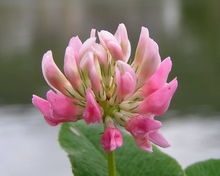Horses grazing in pastures where clover is present face health problems depending on the type of clover, how much is present in the forage, and whether or not it is contaminated with fungus or other toxins. Hay can also be contaminated with clover if it is improperly put up or stored improperly.

Alsike clover - toxic to horses
Horses grazing in pastures where clover is present face health problems depending on the type of clover, how much is present in the forage, and whether or not it is contaminated with fungus or other toxins.
© 2015 by Pethan
Three of the most common problems found in horses eating clover involve:
- The toxin slaframine in Red Clover infested with Rhizoctonia leguminicola which causes excessive salivation
- A photosensitivity response created by Alsike clover(Trifolium hybridum) that is secondary to liver damage
- Sweet clover poisoning that results from molds that grow in sweet clover silage or hay that is put up while too wet.
The red clover plant itself is not toxic. The toxin, slaframine, is produced by the Rhizoctonia fungus which grows on clovers and alfalfa during periods of stress (high humidity, drought, and continuous grazing). Hay made from contaminated forages is also suspect, and the slaframine can remain in hay for several years.
When consumed while grazing or as hay, clover infected with this fungus will often cause horses to slobber excessively. This is known as Slaframine poisoning. The fungus infects red clover, white clover, alsike clover, and alfalfa. Slaframine poisoning is not life-threatening, but it can cause excessive salivation,
The slaframine stimulates the salivary glands and causes horses to drool. Although this is a nuisance, horses rarely suffer any health effects from grazing infected clover.
Other symptoms occasionally include tearing, skin lesions, difficulty breathing, increased urination and feed refusal. It is not uncommon for some horses in a pasture to be more effected than others, since horses vary in their preference for clover and sensitivity to the toxin.
There are several strategies to reduce drooling caused by Rhizoctonia:
- Remove horses from infected pastures.
- Mow pastures until brown spots are no longer present on the leaves.
- Increase the concentration of grass by applying nitrogen fertilizer in spring and fall.
- Rest and rotate pastures to allow the grass to remain tall and competitive with the clover.
- Broad leaf herbicides, labeled for pasture use, can be used to remove existing clover plants from pastures.
Alsike clover creates a photosensitivity response secondary to damage in the liver caused by alkaloid in the plants. Chronic or nervous clinical signs and liver disease including biliary fibrosis and epithelial proliferation may occur.
This photo-sensitivity is caused by photo-reactive pigments in the plant that are absorbed into the blood when the horse eats the clover. In the presence of ultraviolet light from the sun, these then react in areas of non-pigmented skind and the horse's skin sunburns. Generally a horse has to consume these plants for several months before the liver effects become severe.
The best strategy is to remove all alsike clover from pastures by using a recommended broad leaf herbicide labeled for pasture use and rotate crops to allow grass to be competitive with the clover.
Sweet clover poisoning occurs as a result of molds that grow in poorly managed sweet clover silage or hay that is put up too wet. The chemical dicoumarol in the molds blocks normal blood clotting in animals that consume large quantities. Commonly found in commercial rodent poisons, dicoumarol is readily eaten by animals.
Signs of sweet clover poisoning include abnormal bleeding with spontaneous noseblees and black-tar-like manure. Swelling of joints, lameness and difficulty in breathing can occur if heavy doses are consumed.
Treatment consists of removal of the feed source and administration of vitamin K to restore normal blood clotting.
Again, proper pasture management can prevent sweet clover from becoming a major part of forage and proper management of hay storage to minimize presence of clover and conditions that allow mold to grow should be a priority.
